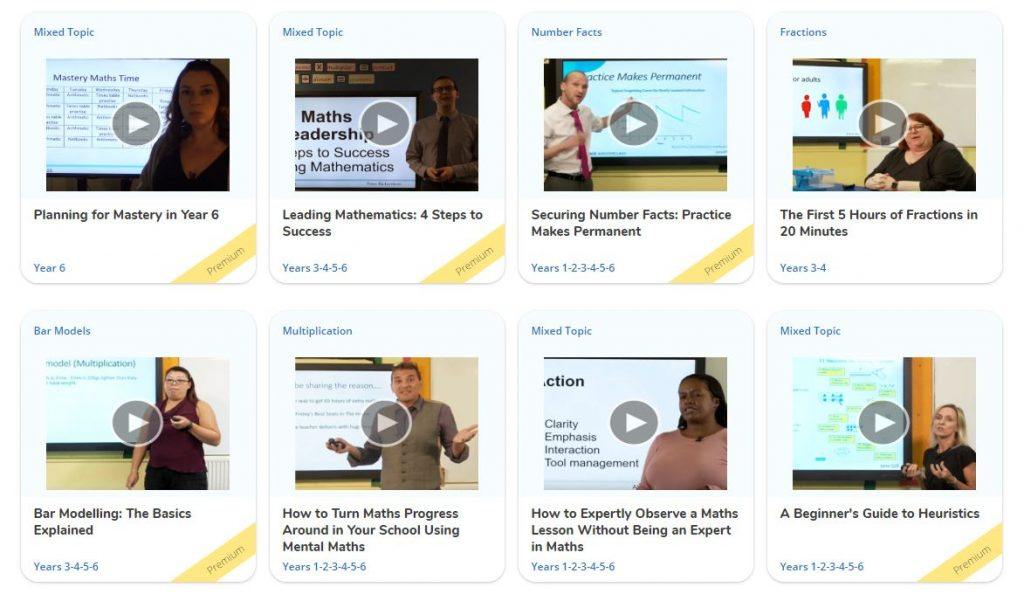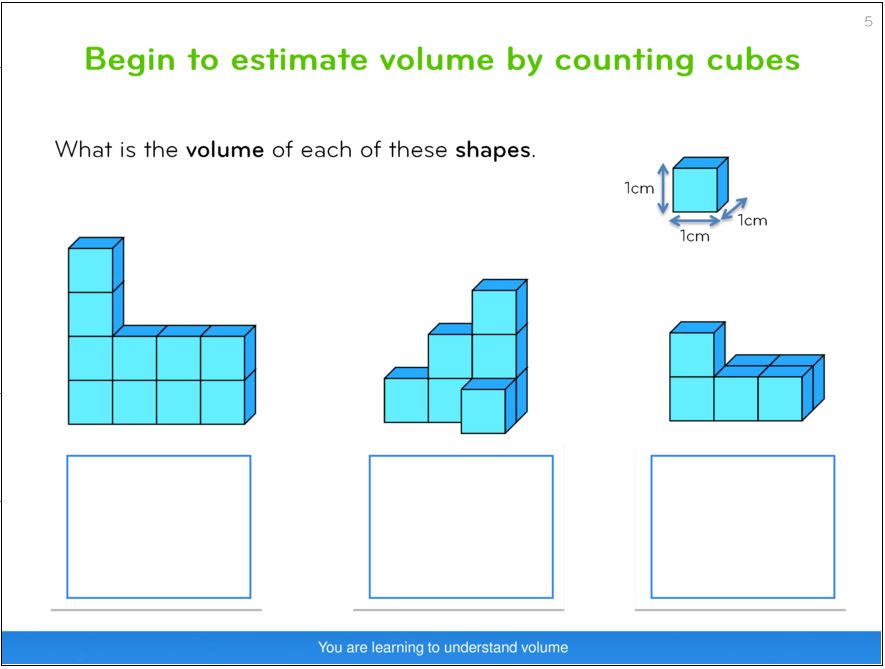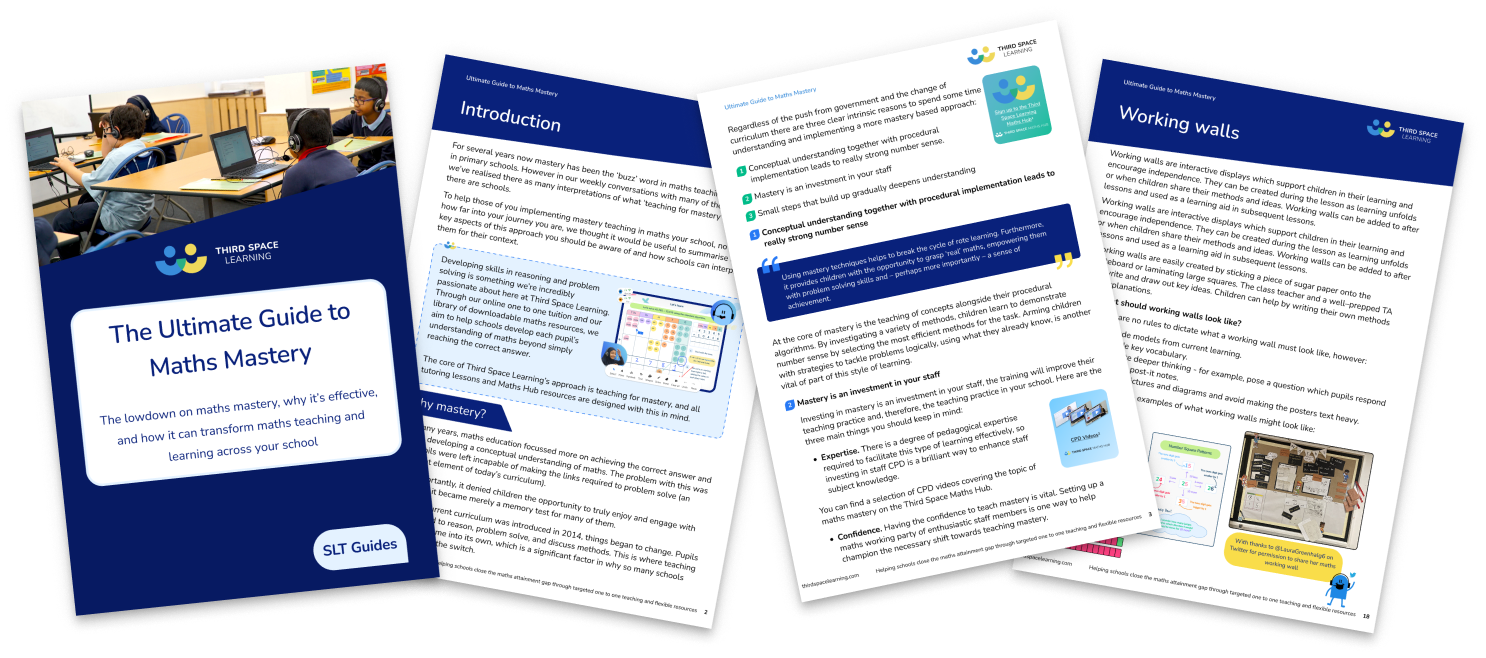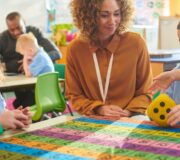Maths Mastery Toolkit: A Practical Guide To Mastery Teaching And Learning
Use this maths mastery toolkit of guidance and mastery resources to support staff and teachers in your school to deepen their understanding of teaching for mastery in maths.
Written by Third Space Learning’s own maths mastery expert Wendy Liu this maths mastery toolkit of resources and techniques to use in your lessons emphasises the practical tools you’ll need rather than the theory behind maths mastery.
For a more theoretical approach to the underpinning of mathematics mastery, we recommend you look at this article on the origin and definitions of mastery maths and teaching for mastery as used in UK schools today.
How Third Space embedded maths mastery in our interventions
When the new national curriculum was introduced in 2014, Third Space completely revised our own programme of one to one lessons that we use in our maths intervention. This helped us align with the scheme of work that each school used to ensure each pupil still benefitted from one-to-one tutoring.
The Ultimate Guide to Maths Mastery
This guide provides essential information for implementing a mastery approach to mathematics in primary schools. Use for staff meetings and self-assessment.
Download Free Now!The aim of this article and the accompanying free downloadable maths mastery resource is to empower leaders and teachers to really embrace the principles of maths mastery teaching, confident that they understand the reasons behind it, and how to follow a maths mastery approach.
Here’s what we’ve learnt. We hope it’s useful for you, whatever stage you’re at on your maths mastery teaching journey.
- Origins of maths mastery
- Why choose a maths mastery approach to learning?
- Grouping and setting in maths mastery
- How to plan a maths mastery lesson
- Maths mastery resources
- Fluency reasoning and problem solving
- Differentiation and assessment as part of maths mastery
- Teacher Research Groups
- Growth mindset within maths mastery
- Use of maths manipulatives
- Anchor charts
- Journalling for maths mastery
Origins of maths mastery
Until recently, teaching children to ‘follow a process’ had been at the core of maths education. Explaining how or why something happened became merely an afterthought.
As long as a child got the answer correct, their comprehension of the method was less important.
However, by not teaching children conceptually, we left them incapable of making the necessary links required to problem solve (an increasing priority in the new 2014 Maths curriculum).
More importantly, it denied children the opportunity to truly enjoy and engage with mathematics – as it became merely a memory test for many of them.
With the 2014 new curriculum, this began to change. Increasingly children are required to reason, problem solve, and discuss methods. This is where teaching for mastery shines, which is partly why so many schools have begun to make the switch to a more asian-style Shanghai maths approach.

Meet Skye, the voice-based AI tutor making maths success possible for every student.
Built by teachers and maths experts, Skye uses the same pedagogy, curriculum and lesson structure as our traditional tutoring.
But, with more flexibility and a lower cost, schools can scale online maths tutoring to support every student who needs it.
Watch Skye in actionWhy choose a maths mastery approach to learning?
Let’s start with the obvious question. Why this approach? Put simply it works. Children with deep conceptual knowledge, who are fluent in number facts, while still able to reason and problem solve are better equipped for the challenges of everyday maths they’ll experience in the real world, and the maths of secondary school.
No to mention the fact that the KS2 SATs are developed around the new maths mastery curriculum with a significant proportion of the marks devoted to mathematical reasoning.
We’ve explored some of the benefits of maths mastery in this
We’ve explored the benefits in our blog on the 6 top reasons that you should adopt maths mastery in year 1 to year 6.
Maths mastery achieves deep conceptual understanding
Using maths mastery techniques helps break the cycle of rote learning in mathematics. It provides children with the opportunity to grasp ‘real’ maths, empowering them with problem solving skills and – crucially – a sense of achievement.
Teaching concepts alongside procedural algorithms is at the core of mastery. By investigating a variety of methods children learn to demonstrate number sense by selecting. the most efficient methods for the task.
Notably, it arms children with a variety of strategies to tackle problems logically and independently, using what they already know.
Maths mastery training will improve teaching in your school
As we all know the single most important factor in pupils’ outcomes in any subject is the quality of the teaching they receive. Maths mastery training and professional development is available from many different providers through the National Centre of Teaching Mathematics NCETM and their network of maths hubs being the most widespread.
Third Space Learning’s own maths hub includes lots of CPD videos for teachers and TAs that follow a maths mastery approach in teaching and look at different aspects of maths teaching such as partitioning, using a number line, the bar model etc.

There is a degree of pedagogical expertise needed to make mastery work in any school. Investing in this means investing in staff CPD, which will inevitably enhance subject knowledge.
Having a team of Maths teachers you can trust, who are confident in their ability to teach using mastery techniques means you have a team who will doubtless champion a shift towards embedding the approach across your school.
These passionate teachers will then help disseminate the teaching techniques throughout your staff.
Small steps lead to deeper understanding
Mastery is not a quick fix and the whole school needs to be on board and committed. It will take time for teachers to learn how to effectively teach each topic.
Small increments of learning are fundamental to this approach. As is “over-teaching” core concepts such as number and place value and the four operations.
Due to this, the initial progress of children taught this way may seem less dramatic when compared to traditional Maths teaching.
However, this is simply because this style of incremental learning ensures children have a thorough conceptual understanding of the Maths, so that no gaps in that area remain.
This avoids instances where the class teacher tries to move on to a new concept, only to discover the class is simply not ready. The “jump” is too large.
Teachers can make formative assessments during lesson and through detailed marking, allowing the class to advance at the same time.
By taking smaller steps through learning, maths mastery teaching lead to deeper understanding of mathematical concepts, as children are given ample time to internalise their maths learning.
Grouping and setting in maths mastery
The debate about ‘setting’ children into ability groups is an ongoing one. Many feel that doing so is beneficial: it’s undoubtedly easier to plan for and teach to a smaller spectrum of ability, and it does work well when teaching children to apply a set of rules.
However, maths mastery teaching is different. Here, the teacher no longer tells the pupils what to do; instead they facilitate learning by guiding the pupils to think for themselves. Communication is a vital part of this process.
Increased metacognition and peer discussion within mixed ability classes
It is through peer discussion, and the proving and disproving of ideas, that metacognition happens (being aware of one’s thought processes).
Given that peer discussion in mastery teaching and learning is so important you should consider the advantages of the mixed ability classroom:
- There will be more fruitful discussions for lower ability children to participate in.
- The higher ability children have the opportunity to explain their methods to lower achievers which ensures they have ascertained a depth of understanding.
How to manage mixed ability grouping within maths mastery
If a school is introducing a mastery initiative for the first time, then mixed ability grouping can work well up to year 4. However, by year 5 and 6 the range of ability may be too wide to implement a totally mixed group at this stage. In this case, it might be possible to separate the highest or lowest achievers from the rest, however this will depend on the cohort.
Planning interventions such as Third Space Learning’s SATs revision for year 6 to plug gaps in core knowledge is an effective way to ensure that the whole class can progress together. These could be based on an audit of each child’s needs as opposed to one regular intervention group.
Having a ‘maths meeting’ is an effective mixed ability teaching model adapted from Shanghai schools. Here, the teacher is released for 30 minutes in the afternoon to support those pupils who didn’t understand the concepts taught that day.
Challenge rapid learners
Mastery learning happens in small steps which enables all children to move through key points of understanding together. Advanced learners are not left without challenge, as this can be achieved through higher–level questioning and extension tasks.
How to plan a maths mastery lesson
Historically, government schemes (Numeracy Strategy, Numeracy Hour) limited the amount of flexibility teachers had in terms of when they taught each topic.
The new curriculum instead permits a freer approach, as long as a certain amount is covered by the end of each Key Stage. As such, teachers may spend a long time planning and creating resources with a wide range of differentiation.
However, with mastery it is possible to be flexible without the need for excessive planning.
So what should you teach, and when?
Having more autonomy to decide the direction of your lesson is a good thing, but it can leave teachers with questions such as:
- Which topic should be planned first?
- Is there a hierarchy of topics?
- How long should be spent on a topic?
- What are the non–negotiables for each lesson?
- Is there a sensible order of topics to maximise learning?
In answer to these questions there is no definitive order, but there are some concepts that must be taught prior to teaching others. Online tools can aid planning by mapping out lesson objectives, but there are already several maths mastery schemes of work.
Maths mastery resources
The most common maths mastery scheme of work used across by over 70% of English schools is White Rose. It breaks down the curriculum into small steps to teach each term for each year.
To supplement this Third Space have produced a series of White Rose Maths resources, lesson slides and other maths mastery resources.
The following are some samples of maths mastery resources available in the Third Space Learning maths hub
Year 1 Maths Mastery
- Ready-to-go lessons Year 1 Place Value within 10 (Autumn Block 1) Slides and Worksheets
- CPD Presentation – Mastery in Primary Mathematics
Year 2 Maths Mastery
- Ready-to-go lessons Year 2 Place Value (Autumn Block 1) Slides and Worksheets
- The Ultimate Guide to Maths Mastery
Year 3 Maths Mastery
- Ready-to-go lessons Year 3 Place Value (Autumn Block 1) Slides and Worksheets
- Ready-to-go lessons CPD
Year 4 Maths Mastery
Year 5 Maths Mastery
Year 6 Maths Mastery
- Ready-to-go lessons Year 6 Place Value (Autumn Block 1) Slides and Worksheets
- 108 Greater Depth Questions For KS2 Maths Mastery
Find out here how to access all our premium and free maths resources.
Fluency reasoning and problem solving
One of that hallmarks of a mastery maths approach to teaching is that every lesson includes elements of fluency, reasoning and problem solving. This is in stark contrast to an approach which just leaves problem solving for Friday morning.
Children in maths mastery lessons expect to be asked to reason regularly and to have the language to do so. It can take time for children to develop the skills and confidence to do this but as they progress through KS2 maths it really pays off.
Maths problem solving
Third Space Learning has lots of resources to support teachers looking for word problems and maths reasoning questions.
As children progress in their maths understanding they will be expected to work through many two-step and multi-step word problems and also then to tackle the more complex problem solving required for longer problem solving maths investigations.
In order to bring the whole class with you in tackling these it is recommended you seek out ‘low threshold, high ceiling’ activities that enable all pupils to access the learning, but have depth to cater for more advanced learners.
Example Low Threshold High Ceiling activity

This Year 2 question looks at subtraction.
For many children, 31 – 5 can be meaningless and confusing. Renaming (or exchanging) the numbers in a context that is familiar to children gives the maths meaning.
Exploring the problem through discussion, and coming up with the number sentence as a class, means children are more likely to access the maths.
Allowing children to do this independent of the teacher also has merit. The teacher can circulate the room, assessing learning and asking questions to support learners or challenge their thinking.
Differentiation and assessment as part of maths mastery
For more advanced learners, challenge can be achieved by proving their answers or explaining a method that they have used, or thinking of an alternative method to solve the above problem as they progress towards greater depth in maths.
For struggling learners, they may approach the above problem by counting the number of remaining balloons or using maths manipulatives like base ten.
Children need ample time to explore and demonstrate ‘exchange’ with physical equipment. Once this has happened, learning can be linked to the column method. At each stage, pupils should be able to explain what is happening by referring back to the balloon context.
This is only possible if children have a solid understanding of place value and the base ten system – without this, the ‘crossing out’ and ‘carrying over’ just becomes a learnt procedure.
Differentiation through teacher expectation and challenge
Differentiation in the classroom during maths mastery lessons is not presented on different worksheets, but through teacher expectation and challenge. The positives of this are twofold: less time-consuming planning and boosted confidence for lower ability children (as the work isn’t tiered).
For quick finishers, in depth questions such as these can be used to further their learning:
- “Can you come up with a ‘brand new’ technique to solve the problem?”
- “Can you write a leaflet to explain what you were working on today for an absent classmate?”
- Can you create your own problem that practises this concept.
By assessing what they have written, teachers gain insight into pupils’ depth of understanding and highlight any possible misconceptions.
Know the lesson inside out
To teach for mastery means being prepared, and teachers need to take into account what the non-negotiables are for that lesson:
- Subject knowledge. How best to teach the concepts with sound pedagogy
- Having a deep understanding of the topic and knowing the com the common misconceptions.
- Technical terms. Introducing the correct terminology
- Expectations. Having an expectation that children answer in whole sentences, using mathematical language
- Feedback. If possible, encourage staff to plan together and give feedback of practices that were or were not successful.
Useful resources
- Maths Terminology (KS1& KS2): How to Teach Primary Pupils Maths Vocabulary So They Can Use It
- How To Help Primary School Pupils Develop The Maths Language Skills They Need To Succeed In SATs
Spend ample time on concepts
‘Over–teach’ concepts, especially the core areas of:
- Number and place value
- Four operations
- Times table and division facts
Seeing patterns and structures in Maths is the key to being able to generalise thinking and enables children to make sense of topics such as fractions and decimals.
Children will be unable to see, for example, the relationship between equivalent fractions if they don’t know their times tables.
Read more
Questioning techniques within a maths mastery lesson
A hugely important part of a mastery classroom is questioning in the classroom. More traditional ‘chalk and talk’ maths lessons can be transformed into an excited discussion by incorporating good questions.
In successful mastery classrooms, it is common to see hands thrown in the air in order to prove or disprove what has been asked. A cleverly asked question will see children ‘struggling’ between their own preconceived ideas and the logic that may be in front of them.
The peer discussions that take place as a result of questions posed are invaluable as a way for teachers to assess levels of understanding, and as a platform for pupils to learn from one another
True mastery in maths is demonstrated when two elements are combined:
- The reasoning and justifying of a concept.
- The correct use of technical language needed to convey a message.
What does a primary classroom following maths mastery look like
- Noise level quite high: This will be good noise – pupils on task trying to prove their point during peer or group discussions.
- Teacher circulating: Asking appropriate questions will facilitate learning and deeper thinking.
- Unbiased attitude: It is important that the teacher neither validates nor rejects an answer or a theory.
- Direct instruction: The teacher is the expert and it is to be expected that at times during a lesson, such as when introducing new content, they will be sharing their expertise following a relatively prescriptive format.
How to handle questions and answers
When a question is asked and answered, a teacher won’t confirm the answer as correct or incorrect or the rest of the class will no longer think for themselves.
An alternative approach is to ask several children what they think the answer is before asking, ‘How do you know?’
It is up to the whole class to justify and reason the theory correct or incorrect. Teachers avoid ‘telling’ the students the answers, and the pupils have to work out why it must be correct – a more powerful type of learning that helps link concepts together.
What questions to ask in a maths mastery lesson?
Some generic questions to ask that are perfect to help assess learning include:
- How do you know?
- Can you prove it?
- Can you come up with a different method?
- What do you notice?
- Will it always do that, and why?
- What happens if?
- Does your answer seem reasonable? Why/why not?
- What do you notice?
- Will it always be true?
One of the most important parts of challenging higher ability children is questioning. The power of a simple question should not be underestimated.
Teacher Research Groups
Teachers require in-depth knowledge of the topic for maths mastery – something that may not come naturally but can be learnt. To aid this, it is good practice for teachers to share things that went well and things that could be improved. Learning from each other and not being afraid of making mistakes are significant parts of mastery.
‘Teacher Research Groups’ are very common in Asian countries – however, they are given dedicated time for these meetings to happen. Nonetheless, it is possible to promote such feedback informally.
Lack of knowledge shouldn’t deter a teacher from asking questions beyond their own understanding. In fact, allowing advanced learners to discover and explore, can lead to the teacher learning something. This is beneficial as children enjoy seeing teachers who don’t know all the answers.
Growth mindset within maths mastery
The power of having an open mind is a teaching and learning asset. A growth mindset from a learner’s point of view is the self belief that you can improve at anything if you work at it, and that the brain gets ‘stronger’ as you do.
Pupils with a growth mindset:
- Thrive on challenge
- Are resilient to setbacks
- Show a great deal of perseverance
A fixed mindset is the opposite:
- Those that give up easily
- Say things like, “I can’t do it!”
- Won’t even attempt something new
- Are afraid of making mistakes
- Never answers in class unless they are 100% sure
- Rub out mistakes in their books
How can teaching for mastery help with creating a growth mindset?
A mastery class adopts a ‘can do’ attitude. There is an underlying message that all children can learn maths and that no one is born being ‘good’ or ‘bad’ at maths.
Mastery aims to promote a growth mindset, providing a safe environment where mistakes are celebrated as a key to unlocking new learning. Through class discussions, misconceptions are challenged by concrete proof. This provides evidence that the ‘understanding’ a child had before must have been incorrect.
It is vital to approach this in a supportive way, so no child is made to feel uncomfortable or stupid.
As mastery is about conceptual learning, children begin to make links across Maths. As their understanding improves, self-belief and confidence grow. Therefore, over time children begin to look forward to the challenge of Maths as opposed to be daunted by the prospect.
Read more
- What is a growth mindset
- How to develop a growth mindset in the classroom
- Growth mindset in your primary school
Use of maths manipulatives
In mastery, it is widely accepted that children learn best through a Concrete Pictorial Abstract approach (CPA).
The initial concrete phase brings concepts to life by using physical objects. Manipulatives play a key role in this as they are the concrete resources used to support pupils thinking as they explore abstract ideas.

Using something ‘real’ to make sense of the maths takes away the need to imagine or visualise at the early stage of learning a new concept.
Best practice use of manipulatives
- Investing, not only in resources, but also on training will ensure that maths manipulatives are used effectively.
- It is important that manipulatives are not solely relied upon – there is a danger that over–reliance on equipment will hinder progress.
- With experience, teachers will gauge when is most appropriate to use materials, which materials to use and when they should be removed. This can also be personalised to individual children depending on their needs.
Choose the concrete resources you need
Overall, you should allow autonomy when choosing equipment. When children are familiar with the manipulatives and how to use them, give them a chance to select their own choice of equipment to represent the problem they are to solve.
This is helpful because:
- The teacher can see how well the student has understood the concept by assessing the relevance of the resources chosen.
- It promotes high–level thinking – pupils have to ensure that the resources chosen are made relevant to the problem and represent it adequately
Anchor charts
Anchor charts are posters based on key concepts in a lesson and help children to ‘anchor’ their learning to these displays. They can be created during the lesson as learning unfolds or when children share their methods and ideas.
Anchor charts are another tool borrowed from Asian maths mastery; they’re similar to the knowledge organisers that many school have started using as part of their curriculum work.
Anchor charts can also be created post lesson and used as a learning aid in subsequent lessons. They should be constructed with the pupils and can be made personal by adding the name of the author: e.g. ‘David’s method’. They then serve as a memoire to learning and should be displayed prominently in the classroom and referred back to when appropriate.
Anchor charts should be utilised whenever there is a purpose for having one displayed in the classroom. This may differ year on year as it is somewhat dependent on the cohort of children.
What to put on your anchor charts
Anchor charts are easily created by sticking a piece of sugar paper onto the whiteboard. The class teacher and a well–prepped TA can write and draw out key ideas. Children can help by writing their own methods and explanations.
- There are no rules to dictate what an anchor chart must look like, however:
• It should be clear and precise.
• It should be colourful and neat.
• Use of diagrams and pictures ensures that it is easier to read and understand.
• Include a challenge or an in–depth question can promote thinking in learners.
• Avoid making the posters text heavy as pupils will not want to read it. - If there is limited space on the walls, a ‘washing line’ display can be used. Alternatively, arrange the charts so that only the headings can be seen and the relevant pages can been ‘flipped’ to when necessary.
Look for your free download: Ultimate Guide to Maths Mastery for some examples of what anchor charts look like.
Journalling for maths mastery
A huge part of the National Curriculum 2014 required students to develop reasoning and fluency with number facts in Maths, but most teachers had difficulty evidencing this – particularly if work that was set was just a page of calculations.
A way to combat this was to introduce the ‘Maths Journal’ – a book dedicated to the thoughts and justifications of the individual pupil.
Here, children can log and articulate the different methods and ideas for solving a problem, enabling teachers to assess what is going on inside the child’s head.
Journalling could be considered a ‘window into the child’s thinking’ and where misconceptions arise, they can be dealt with in a meaningful way.
5 things your pupils might journal
- At the start of a ‘new’ topic children can journal what they already know and what they would like to find out.
- As the topic progresses, children may journal about their thought processes and practices that they have used to come to a solution.
- They may also journal about the different methods, techniques and strategies that they have come across, explaining their understanding.
- When looking at various methods, children may want to comment on the most efficient and explain why the efficacy is dependent on the numbers used.
- Towards the end of the topic, children could log what they have learnt in the unit of work and use examples to demonstrate their learning.
What they log is entirely up to the teacher, however their journals should provide teachers with a clear path of learning and progress that has taken place for each individual child.
Aside from the ongoing assessment that takes place during a lesson, journals are a fantastic source of formative assessment. However, this can only work effectively if books are marked and kept up–to–date.
When, why and how to journal
Daily journalling – All students should keep a journal, but when to write in it depends on what learning the teacher wants to log. Daily journalling is recommended if different concepts are being introduced each day.
Assess understanding – Aside from being an assessment vehicle, journalising also encourages metacognition as the pupil is being forced to think again about the learning and how best to record it.
Have high standards – One of the fundamentals of journalling is that ideas and explanations are very clear. Precise language and diagrams should be used too. With advance learners, the expectations and the quality of work produced may be higher than that of a struggling learner, however ideally teachers shouldn’t accept mediocrity – even lower ability children are able to use representations to explain what they are thinking.
Help with vocabulary – Producing a list of keywords with the class will help children focus their work further.
A typical journalling session should only last 10–15 minutes, so there shouldn’t be copious amounts of marking. However, teacher feedback should help the pupil to identify an underlying misconception, whilst next step marking can promote depth of understanding.
Use of pictures and diagrams
Pictorial representations are just as vital as concrete materials. These are particularly helpful for engaging EAL pupils, SEN pupils and visual learners, as well as being a platform to express their understanding. Initially, the teacher may need to model different visual representations but as the children get used to using them, they may well go on to create their own.
There is no right or wrong model as long as it expresses accurately an explanation.
Look for your free download: Ultimate Guide to Maths Mastery for some examples of what journalling can look like.
Bar modelling – the cornerstone of maths mastery
Bar modelling was developed and used in Singapore and are an effective visual tool to help students break down, understand and solve a problem. Children need plenty of exposure to the different types of bar models before they can use them productively.
Through maths mastery learning, children should first learn the simple bar model method to solve addition and subtraction maths word problems, then multiplication and division. Gradually as they move towards maths mastery in year 6 they progress to being able to solve more complex year 6 word problems.
What are bar models?
Bar models are rectangular bars drawn to represent a scenario posed in a worded problem. These rectangles provide a way to ‘see’ the steps and the appropriate operations needed to solve the problem.
They model the worded problem in its most simplistic state, removing all words except for the key information. This allows the student to deal with one section of the worded problem at a time, and gives space to decide whether the piece of information is important in the context.
For EAL and SEN learners, this visual image is powerful, as they no longer need to worry about long sentences which they may find difficult to comprehend – they can now see what they have to do.
How Third Space Learning uses a mastery approach in its one to one tutoring sessions
At Third Space Learning, we follow a mastery approach to our one to one AI maths tutoring sessions as we are of the belief that each topic within maths should be understood in detail before moving on to the next. We also perform regular low stakes micro assessments to check a pupil’s understanding and progress so we can recap or move on as appropriate.
Read more: Interleaving: What Is It And How Can It Improve Memory And Learning In The Maths Classroom?
DO YOU HAVE STUDENTS WHO NEED MORE SUPPORT IN MATHS?
Skye – our AI maths tutor built by teachers – gives students personalised one-to-one lessons that address learning gaps and build confidence.
Since 2013 we’ve taught over 2 million hours of maths lessons to more than 170,000 students to help them become fluent, able mathematicians.
Explore our AI maths tutoring or find out about primary maths tutoring for your school.






